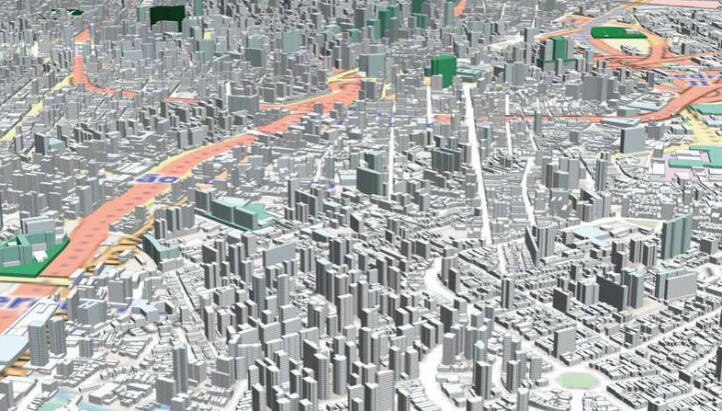As part of an R&D project called REWIRE Northwest - funded by Innovate UK - IES consultants used ICL Digital Twin technology to investigate the potential energy, carbon and cost savings that could be achieved for the Borough of Warrington, to help improve the overall efficiency of the area’s buildings.

Creating the Model and Data Population
Bridging the gap between the real world and simulation, ICL Digital Twin technology enables the energy efficient design and continuous operational optimisation of not just single, but entire groups of buildings.
Warrington Borough is too large to be modelled as a whole, so it was split into 29 separate areas. The data was gathered from various sources including the Borough Council, the EPC (Energy Performance Certificate) database and local Distribution Network Operators.
The various data types examined many elements such as geo-located geometry, property references, building use, construction dates, building characteristics and the electric network infrastructure – even down to roof insulation.
The data from each building underwent an import process, where each of the 29 areas was individually modelled in iCD (intelligent Community Design) software, part of the ICL Digital Twin suite of technology – the masterplanning and urban design tool. It can analyse and monitor how the community may evolve over time, and track the impact of changes on key environmental metrics such as solar power potential and impact on resource consumption.
The iCIM – the online collaboration platform hosting the final digital twin of Warrington – allowed IES to collate all 29 models within a single platform.
Building Archetypes
The objective of the modelling was to assign an archetype model to each residential building within the borough. The results were brought back into the digital twin of each building, based on their specific archetype.
“Using our investigation on the EPC database, we gathered information from over 50,000 properties, based on build characteristics, age band, main heating system and total GFA (Gross Floor Area). Four types of residential houses were assessed: detached houses, semi-detached houses, terraced houses and apartments.”
– Keivan Djahanbani, ICL Senior Project Consultant at IES
Retrofit Simulation
Another aspect of the project was to model retrofit scenarios for Warrington to assess energy consumption. Each of the archetype models was simulated and reimported into IES’ leading-edge Apache simulation engine, for later use in the iVN (Intelligent Virtual Network).
Apache is the engine that powers the IES Virtual Environment (IESVE). A bespoke process was developed using Apache for this project to enable the consultants to run several hundred model variations, which would usually take weeks to do, in just a couple of hours.
The iVN is a network modelling and management tool that delivers a holistic view of the site, and integrates electricity, heating, cooling, waste heat networks and share energy across buildings. Assessing existing supply and demand from buildings and other community assets determines the flexibility required across the area to balance demand, and evaluate ‘what if’ scenarios for intelligent operation.
“Three scenarios were considered when the data was input into the iVN, to consider the various ways the buildings could be decarbonised and to improve the overall efficiency. These scenarios covered: low hanging fruits (filling cavity walls, insulating or topping up lofts); low hanging fruit and solid walls (as above, whilst also insulating uninsulated solid walls); and finally, a full retrofit (upgrading to current standards of Part L of the Building Regulations 2013: same as above, as well as floor insulation, improved glazing and reduced infiltration.”
– Fergus Ross, ICL Consultant at IES
Decarbonisation Scenario Simulation
After the results for different retrofit scenarios had been brought into the iVN, various strategies for full decarbonisation could be simulated. This was initially undertaken for two neighbourhoods of around 500 homes. The most optimal solutions for decarbonising heat through heat pumps and district heating, installing domestic PV panels and battery storage, and installing EV chargers were found for each area. This allowed for the creation of bespoke pathways to net zero, with the optimal strategies for each area depending on specific criteria such as the most prevalent built form and construction materials used, the spare capacity on the local substation and the availability of off street parking.
Analysis Reporting
The shared central database and interconnected tools allow IES to easily share data and analysis results across the platform. The analysed data was fed back to Warrington Borough, which laid out the various pathways for a future decarbonisation strategy. IES’ modelling and simulation tools and software are incredibly accurate, enabling Warrington Borough to clearly see the various optimisation scenario models available to them.
The input and output data helped them to understand their potential return on investment for any decarbonisation initiatives they undertake, and to inform financial models.
Easy Replicability
Digital Twin technology modelling is easily replicable to any city in the UK. IES are now submitting tenders to local councils who may be looking to implement a similar digital twin project, which will allow them to approach government bodies with accurate figures, to potentially negotiate future decarbonisation budgets.
The REWIRE Northwest project was funded by Innovate UK
N.B. The information contained in this entry is provided by the above supplier, and does not necessarily reflect the views and opinions of the publisher


